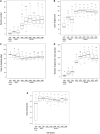A Novel Combination of Genes Causing Temperature-Sensitive Hybrid Weakness in Rice
- PMID: 35837460
- PMCID: PMC9274174
- DOI: 10.3389/fpls.2022.908000
A Novel Combination of Genes Causing Temperature-Sensitive Hybrid Weakness in Rice
Abstract
Reproductive isolation is an obstacle for plant breeding when a distant cross is demanded. It can be divided into two main types based on different growth stages: prezygotic isolation and postzygotic isolation. The hybrid weakness, which is a type of postzygotic isolation, can become a problem in crop breeding. In order to overcome reproductive isolation, it is necessary to elucidate its mechanism. In this study, genetic analysis for low temperature-dependent hybrid weakness was conducted in a rice F2 population derived from Taichung 65 (T65, Japonica) and Lijiangxintuanheigu (LTH, Japonica). The weak and severe weak plants in F2 showed shorter culm length, late heading, reduced panicle number, decreased grain numbers per panicle, and impaired root development in the field. Our result also showed that hybrid weakness was affected by temperature. It was observed that 24°C enhanced hybrid weakness, whereas 34°C showed recovery from hybrid weakness. In terms of the morphology of embryos, no difference was observed. Therefore, hybrid weakness affects postembryonic development and is independent of embryogenesis. The genotypes of 126 F2 plants were determined through genotyping-by-sequencing and a linkage map consisting of 862 single nucleotide polymorphism markers was obtained. Two major quantitative trait loci (QTLs) were detected on chromosomes 1 [hybrid weakness j 1 (hwj1)] and 11 [hybrid weakness j 2 (hwj2)]. Further genotyping indicated that the hybrid weakness was due to an incompatible interaction between the T65 allele of hwj1 and the LTH allele of hwj2. A large F2 populations consisting of 5,722 plants were used for fine mapping of hwj1 and hwj2. The two loci, hwj1 and hwj2, were mapped in regions of 65-kb on chromosome 1 and 145-kb on chromosome 11, respectively. For hwj1, the 65-kb region contained 11 predicted genes, while in the hwj2 region, 22 predicted genes were identified, two of which are disease resistance-related genes. The identified genes along these regions serve as preliminary information on the molecular networks associated with hybrid weakness in rice.
Keywords: QTL; genotyping-by-sequencing (GBS); hybrid weakness; reproductive isolation; rice.
Copyright © 2022 Than Kutay Soe, Kunieda, Sunohara, Inukai, Reyes, Nishiuchi and Doi.
Conflict of interest statement
HS was employed by Environmental Control Center Co., Ltd. The remaining authors declare that the research was conducted in the absence of any commercial or financial relationships that could be construed as a potential conflict of interest.
Figures











Similar articles
-
Genetic Dissection of Germinability under Low Temperature by Building a Resequencing Linkage Map in japonica Rice.Int J Mol Sci. 2020 Feb 14;21(4):1284. doi: 10.3390/ijms21041284. Int J Mol Sci. 2020. PMID: 32074988 Free PMC article.
-
Quantitative trait locus analysis and fine mapping of the qPL6 locus for panicle length in rice.Theor Appl Genet. 2015 Jun;128(6):1151-61. doi: 10.1007/s00122-015-2496-y. Epub 2015 Mar 28. Theor Appl Genet. 2015. PMID: 25821195
-
Isolation of a Novel QTL, qSCM4, Associated with Strong Culm Affects Lodging Resistance and Panicle Branch Number in Rice.Int J Mol Sci. 2023 Jan 3;24(1):812. doi: 10.3390/ijms24010812. Int J Mol Sci. 2023. PMID: 36614255 Free PMC article.
-
Fine mapping of a quantitative trait locus for grain number per panicle from wild rice (Oryza rufipogon Griff.).Theor Appl Genet. 2006 Aug;113(4):619-29. doi: 10.1007/s00122-006-0326-y. Epub 2006 Jun 13. Theor Appl Genet. 2006. PMID: 16770601
-
The molecular and evolutionary basis of reproductive isolation in plants.J Genet Genomics. 2018 Nov 20;45(11):613-620. doi: 10.1016/j.jgg.2018.10.004. Epub 2018 Nov 5. J Genet Genomics. 2018. PMID: 30459118 Review.
Cited by
-
Utilization of Genotyping-by-Sequencing (GBS) for Rice Pre-Breeding and Improvement: A Review.Life (Basel). 2022 Nov 1;12(11):1752. doi: 10.3390/life12111752. Life (Basel). 2022. PMID: 36362909 Free PMC article. Review.
-
THB1, a putative transmembrane protein that causes hybrid breakdown in rice.Breed Sci. 2024 Jun;74(3):193-203. doi: 10.1270/jsbbs.23065. Epub 2024 Jun 13. Breed Sci. 2024. PMID: 39555009 Free PMC article.
References
LinkOut - more resources
Full Text Sources
Miscellaneous

